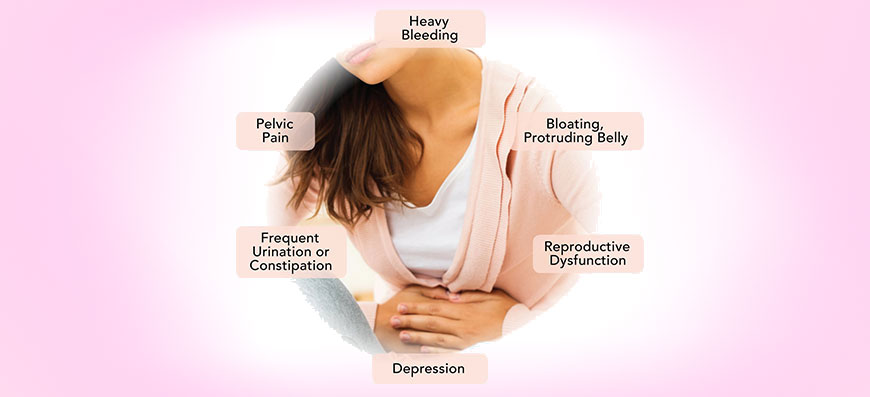IVF Spring > Fertility Conditions > Uterine Fibroids
Uterine Fibroids


Fibroids are otherwise called leiomyomas. They are non-cancerous growths that can occur on the inside of the uterus or outside of it. They may grow on the internal surface of the uterine wall thereby not allowing the embryo to attach itself to the wall. Those outside the uterus may obstruct or compress the fallopian tubes and not allow the sperm to reach the egg. They interfere with pregnancy in more ways than one.
Symptoms of Fibroids
The nature and severity of the symptoms of uterine fibroids depend on the number, location, and size of the fibroids. A patient may experience painful cramping and abnormal or excessive bleeding during menstruation. If the position of the fibroids is such that it exerts pressure on the bowels or bladder, it may interfere with urination or moving of the bowels. Hemorrhoids may develop as a consequence of constipation. If the fibroids are of a small size, there may not be any symptoms and will go undetected until the patient goes for a test for infertility.
Uterine Fibroids – Complications
Some of the complications that can be caused by uterine fibroids are listed below.
- Menorrhagia: This refers to painful and heavy bleeding during a woman’s periods. This can cause a woman to experience fatigue and depression and anemia in the longer term.
- Abdominal Pain: When fibroids are big in size, they are likely to cause bloating and discomfort in the lower abdomen and additionally cause constipation.
- Problematic Pregnancy: Fibroids can cause miscarriages, premature births, and labor-pain issues as the amount of estrogen rise to significant amounts during pregnancy.
- Infertility Issues: Fibroids may cause obstruction of the fallopian tubes. If located on the inside, the embryo may have difficulty in attaching itself to the lining because a submucosal fibroid may cause a change in the shape of the uterine wall.
- Leiomyosarcoma: This is a form of cancer, though rare, that can develop inside a fibroid.
Diagnostic tests for fibroids
The medical specialist will at first conduct a routine pelvic exam to detect uterine fibroids after assessing the medical history of the patient. Along with an abdominal exam, the doctor will be able to detect an irregular mass in the pelvic area that would indicate an incidence of fibroids. Further diagnostic procedures may include the following:
- Ultrasound scan
This method detects uterine fibroids with the help of high-frequency sound waves directed in and around both the uterus and cervix.
- Hysterosalpingogram (HSG)
This procedure makes use of X-rays and a dye to detect uterine fibroids located inside the uterus and also to check if the fallopian tubes are open to facilitate fertilization.
- Hysteroscopy
This involves insertion of a fiber-optic telescope that helps to detect and even remove intra-uterine fibroids.
- Laparoscopy
A narrow fiber-optic telescope is inserted via an incision made near the navel to detect and remove fibroids.
Uterine Fibroids – Treatment Methods
A majority of uterine fibroids cease to grow and sometimes shrink after a woman reaches her menopause. The healthcare specialist monitors the woman’s health at this stage and ensures that there are no major changes to the woman’s health conditions and that the fibroids have stopped growing.
If the fibroids are large and cause various symptoms, other methods of treatment may be necessary. This treatment depends on many factors such as:
- The health of the patient
- The extent of growth of fibroids
- Tolerance for treatment methods such as medications and procedures
- Opinions and preferences
- The desire to get pregnant
- Expectations of the progress of the disease
Depending on all these factors, the doctor may recommend medications or surgery or a combination of both. The fibroids may be removed through laparoscopy, open incision surgery (myomectomy) or hysteroscopy. Alternately for some patients drugs to reduce estrogen production in the body are prescribed. The fibroids usually regrow once the medications are stopped. Therefore medication is an option prior to surgery. Medications are prescribed only for a short period as long-term use will increase the risk of bone loss. Any of these treatments is not a complete cure for fibroids. They can regrow once the treatment is over.
IVF Spring Fertility – Best Treatment for Fibroids
Fibroid treatment at IVF Spring Fertility varies from case to case. In many cases, fibroids need not be treated at all. Our expert senior doctors are experienced enough to advise that no treatment is required at all for specific cases.
